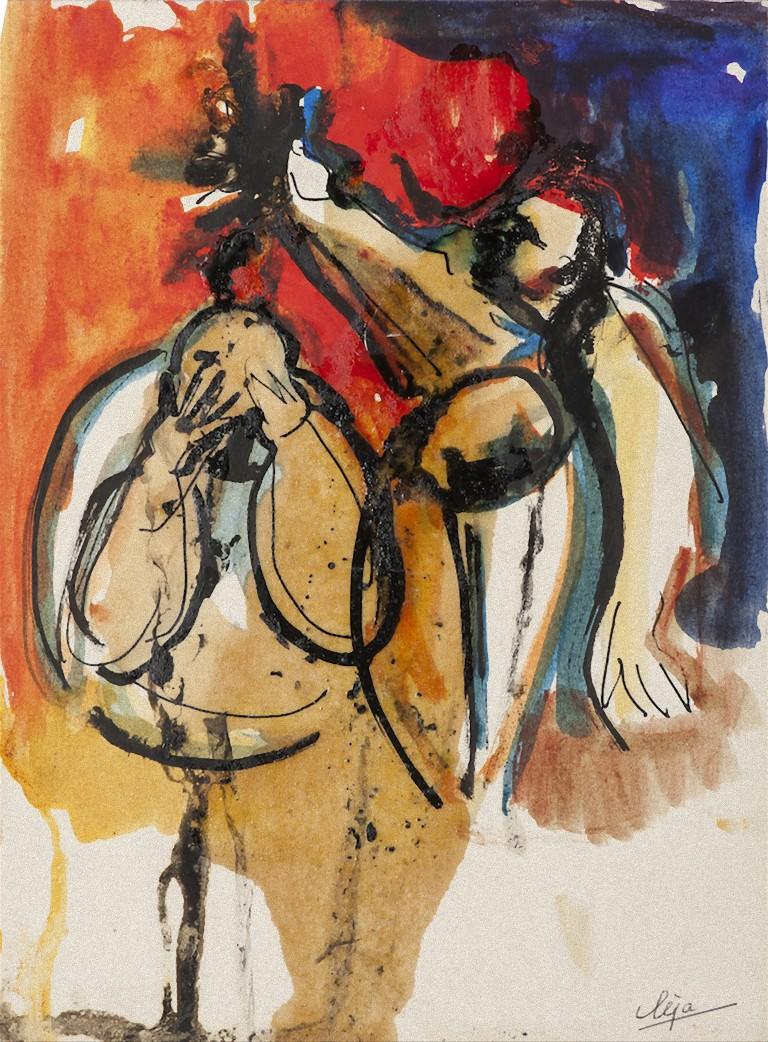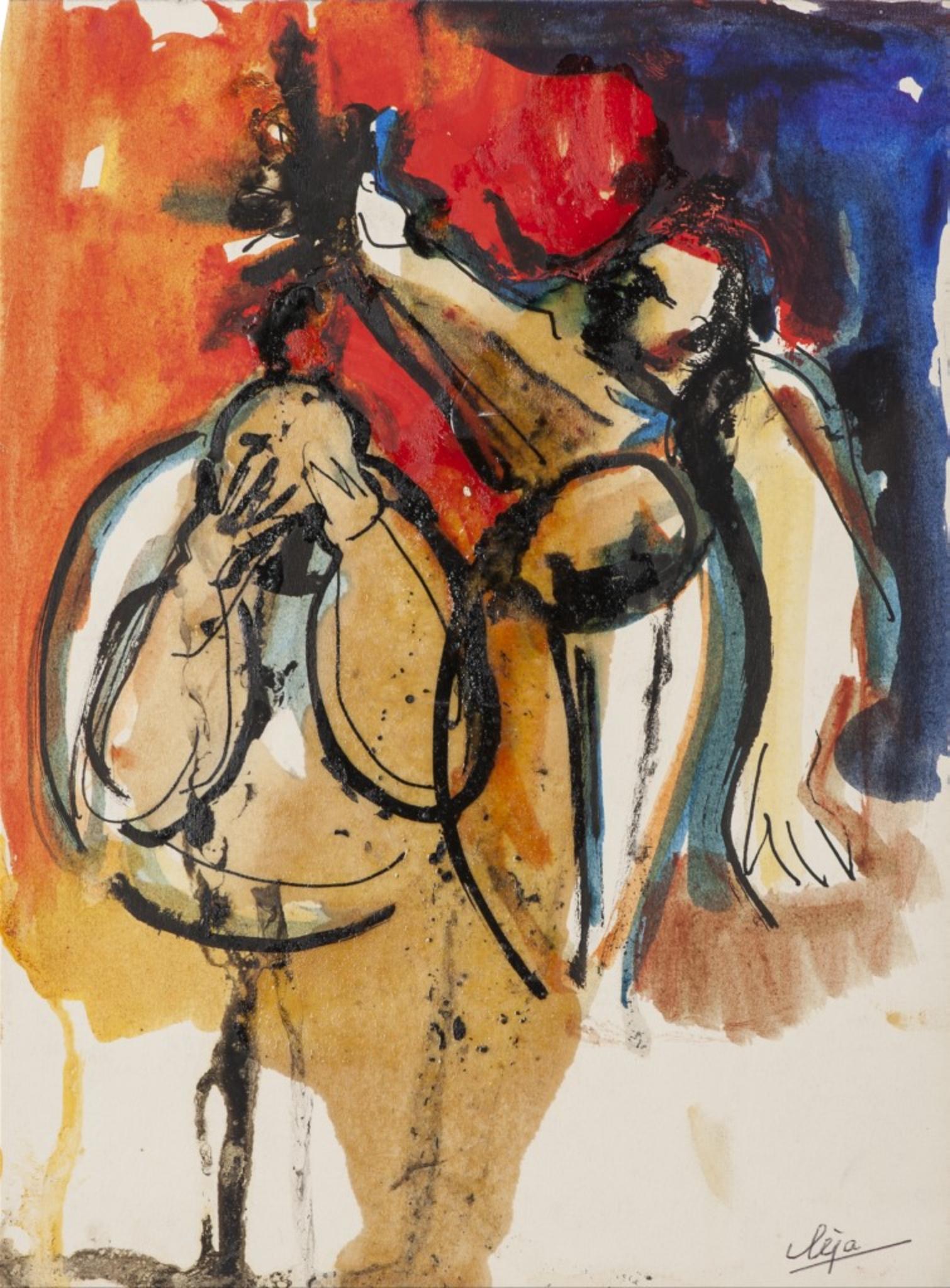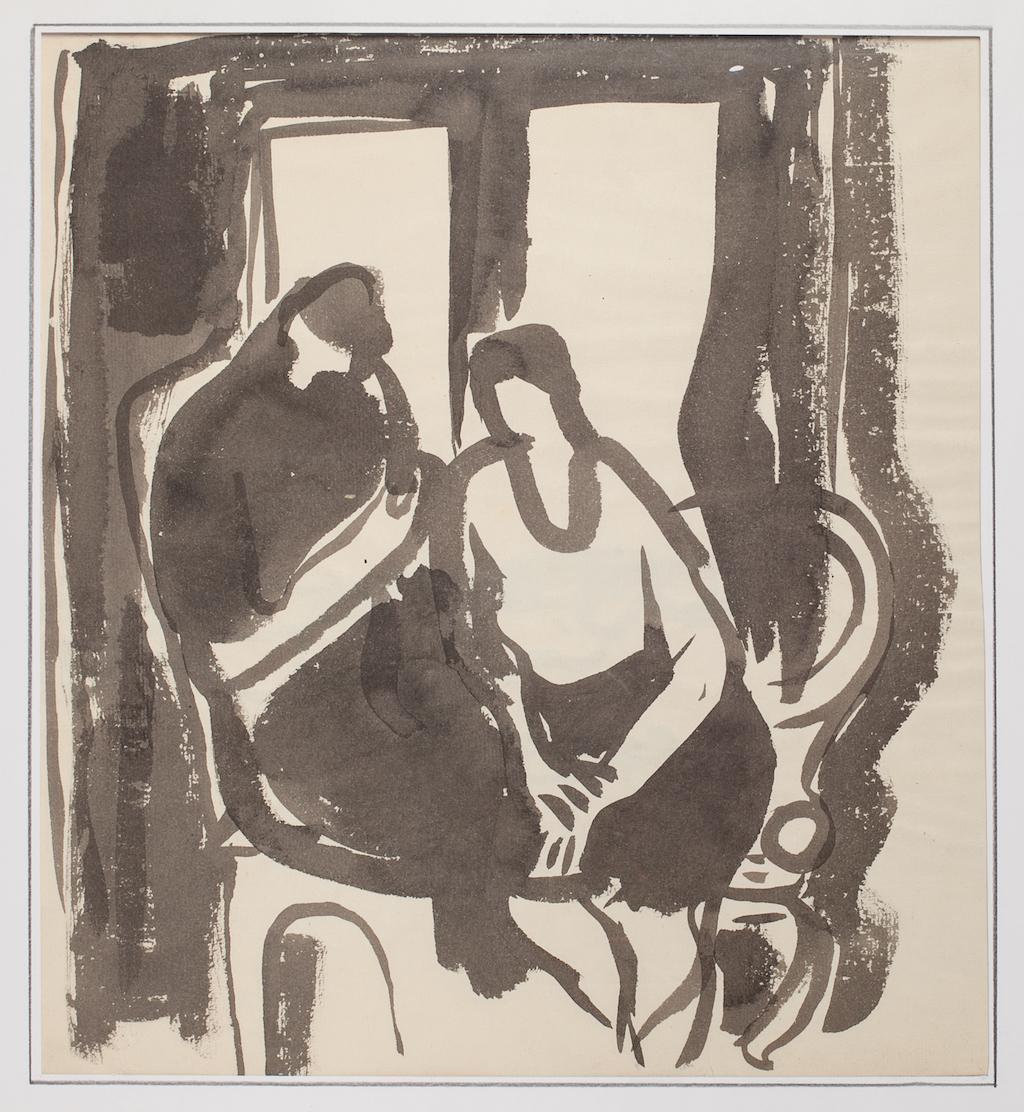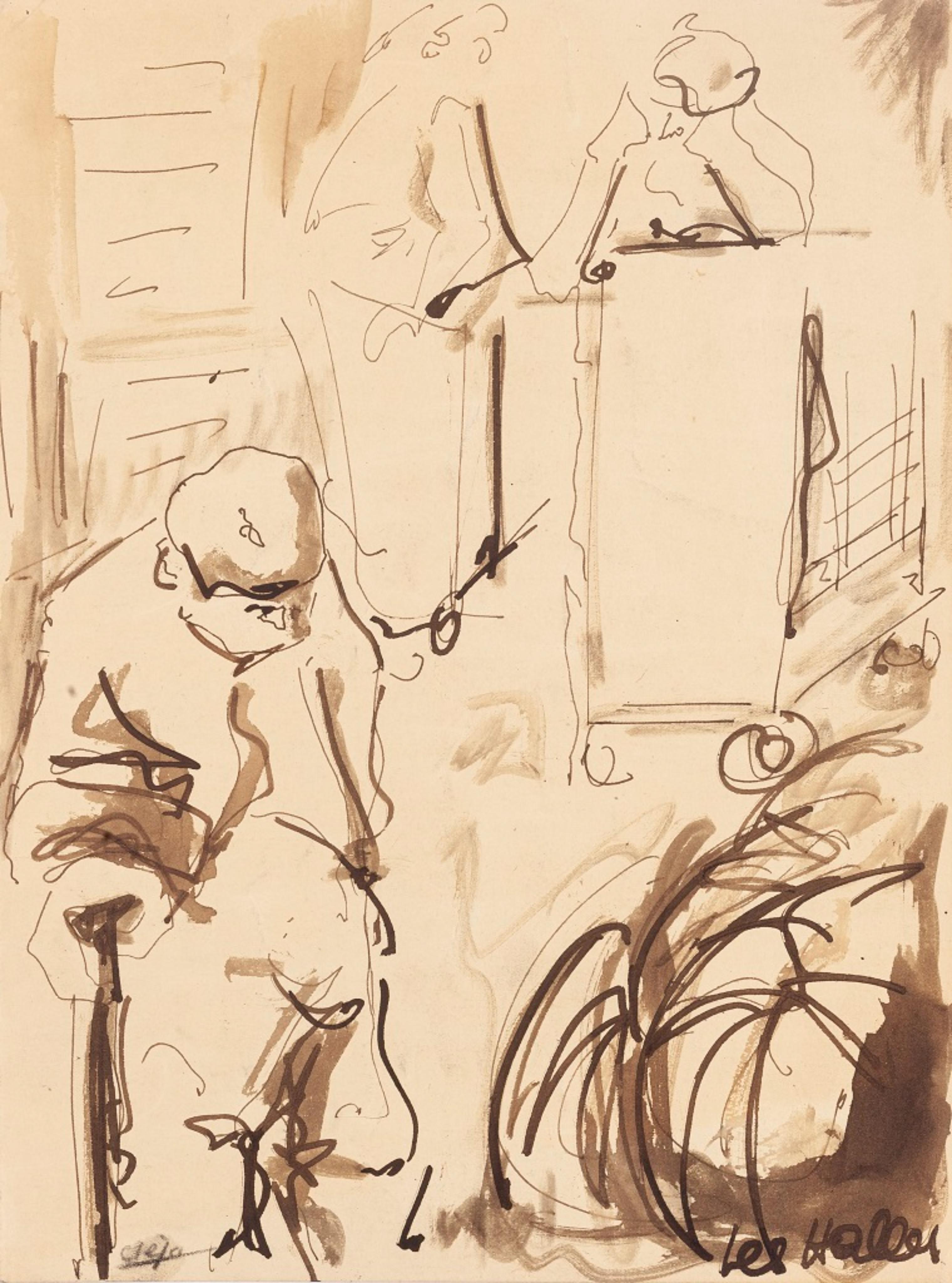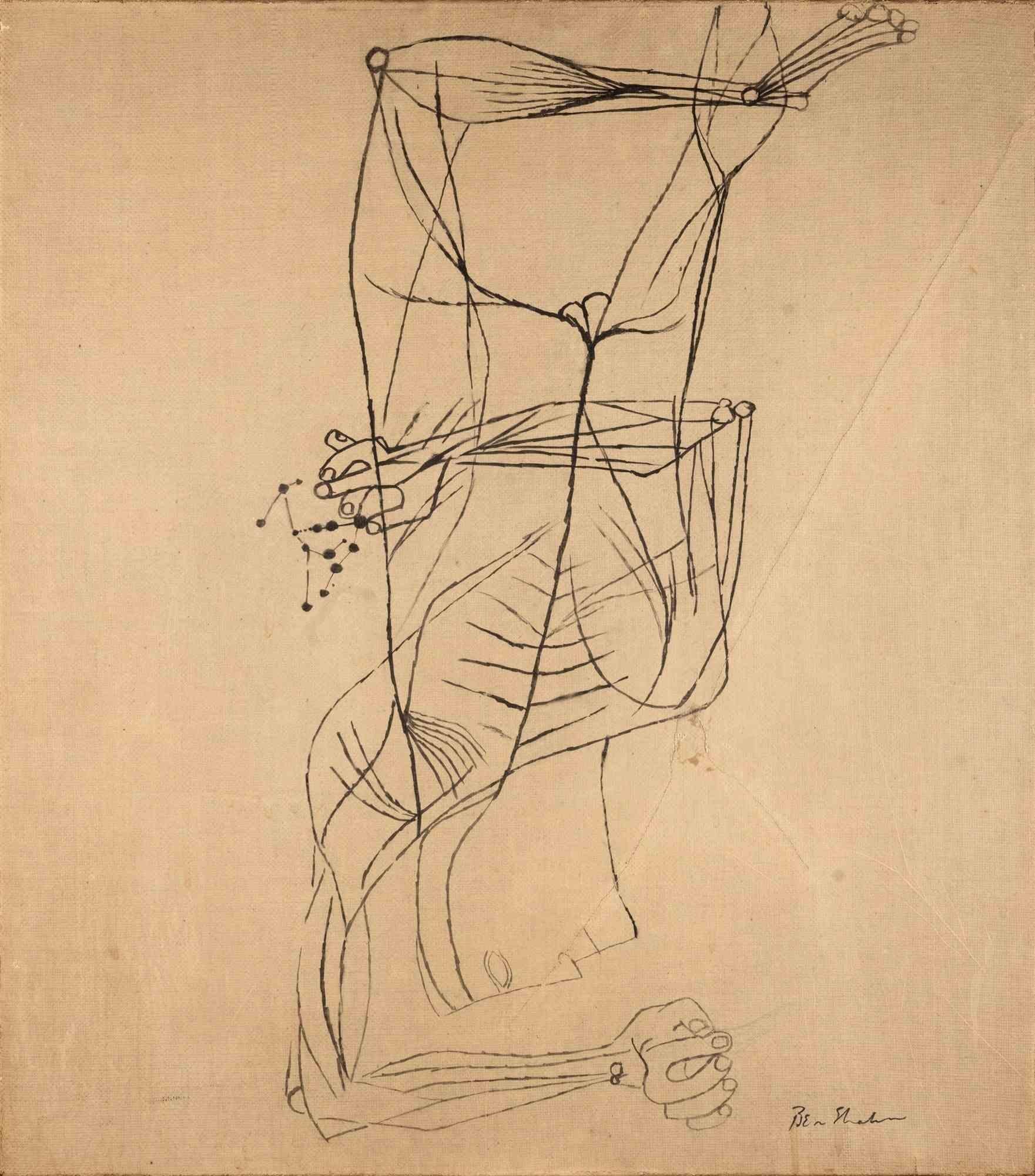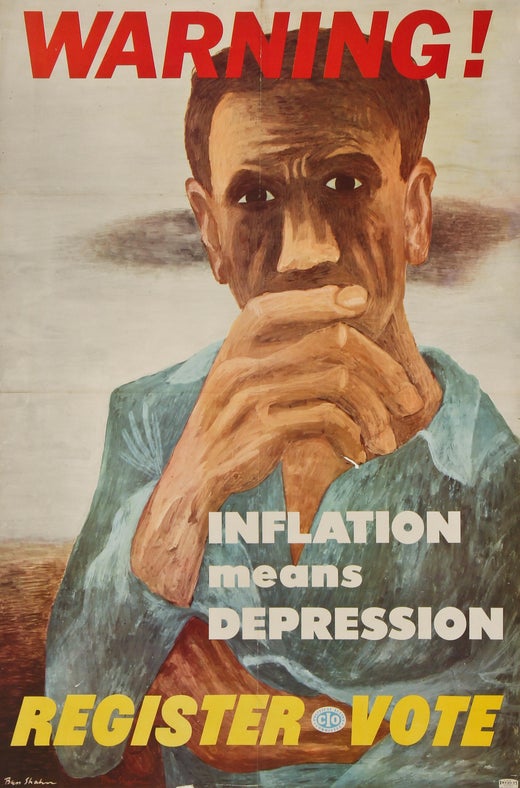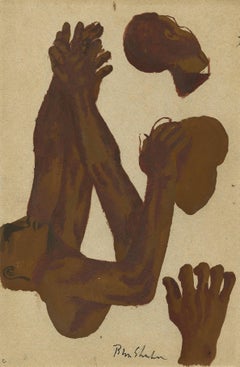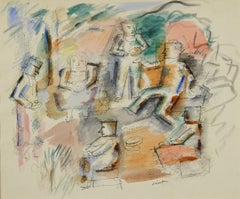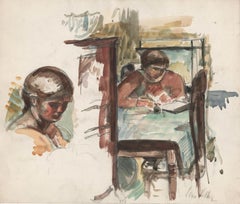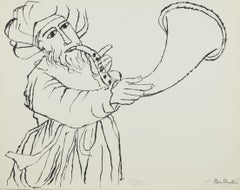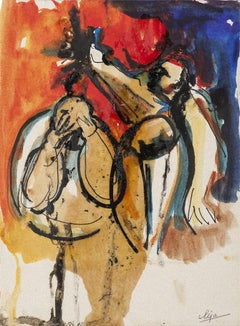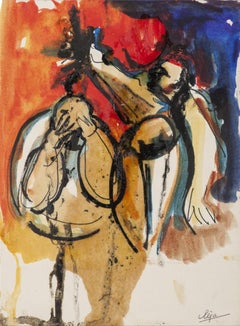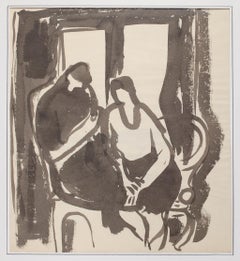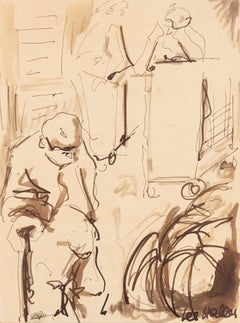Items Similar to Untitled (Double sided watercolor) Recto: Figures seated at a table
Want more images or videos?
Request additional images or videos from the seller
1 of 15
Ben ShahnUntitled (Double sided watercolor) Recto: Figures seated at a tablec. 1960
c. 1960
$3,250
£2,452.69
€2,807.95
CA$4,583.58
A$5,032.20
CHF 2,625.31
MX$60,896.58
NOK 32,904.16
SEK 31,004.37
DKK 20,960.63
About the Item
Watercolor on paper
Most probably related to the artist's creation of images surrounding Haggadah (Passover) which he started in 1930 and finished with the publication of his book in 1965.
Note: Many of the illustrations in Shahn’s Haggadah were made around 1930. However, it was not until 1965 that the artist collected the drawings and watercolors together to form the printed Haggadah. Shahn said that the work “reflects my memories of the Passover in my father’s house. It reflects my early impressions and feelings; the images that were always invoked in my fancy by the majestic and meaningful ritual.” The theme of struggle against oppression, which is central to the Passover story, was a common one in Shahn’s work. At the time the Haggadah illustrations were made, Shahn was also working on a set of illustrations depicting the Dreyfus Affair, in which a Jewish Frenchman was falsely accused of espionage and imprisoned for nearly five years in the infamous Devil’s Island penal colony in French Guiana. From 1961 to 1967, Shahn worked on the stained glass at Temple Beth Zion, a Buffalo, NY synagogue designed by Harrison & Abramovitz.
The Haggadah is a Jewish text that sets forth the order of the Passover Seder. Reading the Haggadah at the Seder table is a fulfillment of the mitzvah to each Jew to "tell your son" of the Jewish liberation from slavery in Egypt as described in the Book of Exodus in the Torah ("And thou shalt tell thy son in that day, saying: It is because of that which the LORD did for me when I came forth out of Egypt."
Provenance: Dr. Elmer Kline, New York
Gallery: Gertrude Stein (see invoice)
Dr. Albert A. Holstein, New Jersey
Condition: Front, very good with fresh colors
Study verso: old mat staining from previous framing
- Creator:Ben Shahn (1898-1969, American)
- Creation Year:c. 1960
- Dimensions:Height: 15 in (38.1 cm)Width: 11.5 in (29.21 cm)Depth: 11 in (27.94 cm)
- Medium:
- Movement & Style:
- Period:
- Condition:Very attractively frame, with a double window (front and back). Ready to hang in your home and enjoy.
- Gallery Location:Fairlawn, OH
- Reference Number:Seller: FA114331stDibs: LU14013412682
Ben Shahn
Ben Shahn (1898 – 1969) was a Lithuanian-born American artist. He is best known for his works of social realism, his left-wing political views, and his series of lectures published as The Shape of Content. Shahn began his path to becoming an artist in New York, where he was first trained as a lithographer. Shahn's early experiences with lithography and graphic design is apparent in his later prints and paintings which often include the combination of text and image. Shahn's primary medium was egg tempera, popular among social realists. Shahn mixed different genres of art. His body of art is distinctive for its lack of traditional landscapes, still lifes, and portraits. Shahn used both expressive and precise visual languages, which he coalesced through the consistency of his authoritative line. Shahn is also noted for his use of unique symbolism, which is often compared to the imagery in Paul Klee's drawings. His art is striking but also introspective. He often captured figures engrossed in their own worlds. Although he used many mediums, his pieces are consistently thoughtful and playful.
About the Seller
5.0
Recognized Seller
These prestigious sellers are industry leaders and represent the highest echelon for item quality and design.
Platinum Seller
Premium sellers with a 4.7+ rating and 24-hour response times
Established in 1978
1stDibs seller since 2013
814 sales on 1stDibs
Typical response time: <1 hour
Associations
International Fine Print Dealers Association
- ShippingRetrieving quote...Shipping from: Fairlawn, OH
- Return Policy
Authenticity Guarantee
In the unlikely event there’s an issue with an item’s authenticity, contact us within 1 year for a full refund. DetailsMoney-Back Guarantee
If your item is not as described, is damaged in transit, or does not arrive, contact us within 7 days for a full refund. Details24-Hour Cancellation
You have a 24-hour grace period in which to reconsider your purchase, with no questions asked.Vetted Professional Sellers
Our world-class sellers must adhere to strict standards for service and quality, maintaining the integrity of our listings.Price-Match Guarantee
If you find that a seller listed the same item for a lower price elsewhere, we’ll match it.Trusted Global Delivery
Our best-in-class carrier network provides specialized shipping options worldwide, including custom delivery.More From This Seller
View AllBasketball Player
By Ben Shahn
Located in Fairlawn, OH
Basketball Player
Gouache on card stock, c. 1940
Signed by the artist in ink lower center
A study for the fresco mural in the Social Security Buildin...
Category
1940s American Modern Figurative Paintings
Materials
Gouache
Interior Scene with Figures
By Louis Schanker
Located in Fairlawn, OH
Interior Scene with Figures
Ink and watercolor on paper, c. 1930's
Signed with the Estate stamp lower center
Condition: Loss upper right corner; two small tears lower margin
...
Category
1930s American Modern Drawings and Watercolor Paintings
Materials
Watercolor
Two Studies of Henriette (Head of the artist's wife & The Artist's wife writing
By Leon Kelly
Located in Fairlawn, OH
Two Studies of Henriette (Left: Head of the artist's wife, Right: The Artist's wife writing a letter)
Watercolor and graphite on paper, 1928-1930
Signed in pencil lower right (see photo)
Image/sheet size: 9 3/8 x 11 inches
Condition: Excellent
Colors fresh and unfaded
Provenance: Estate of the artist
The Orange Chicken...
Category
1920s American Modern Figurative Drawings and Watercolors
Materials
Watercolor
Man Sounding Horn (Psalm 150)
By Ben Shahn
Located in Fairlawn, OH
Man Sounding Horn (Psalm 150)
Lithograph, 1969-1970
Estate signed: "Ben Shahn/by B.B. Shahn" in pencil lower center
Stamped signature lower right (see photo)
Signed by Mourlot Lith. in pencil lower right (see photo)
Edition: 125 (67/125) see photo
Psalm 150, "A Hallelujah Chorus"
Published by Kennedy Graphics, Ltd., New York, NY
Printed by Mourlot Graphics, Ltd., New York, NY
Reference: Prescott 255
Kennedy Galleries, The Kennedy Graphics, 380, reproduced
Condition: Very good
Image/sheet size: 20 1/8 x 25 3/8 inches
A posthumous print
"This was the final project completed by Ben Shahn (1898-1969), leading American realist painter and muralist widely recognized for his socially conscious works. Born in Lithuania to Jewish parents, Shahn emigrated to the United States in 1906 and became a popular and versatile artist who worked in a variety of media and on a range of projects. His credits are as varied as assistant to muralist Diego Rivera, photographer for the Resettlement Administration (alongside the likes of Dorothea Lange and his friend, Walker Evans), maker of posters for the Office of War Information during WWII, and commercial artist for CBS. He is best known, however, for artwork depicting left-leaning political ideals and highlighting social concerns, such as his series of gouache paintings known as "The Passion of Sacco and Vanzetti...
Category
1960s American Modern Figurative Prints
Materials
Lithograph
Untitled (Two Standing Nudes, one seated nude)
By Boris Lovet-Lorski
Located in Fairlawn, OH
Untitled (Two Standing Nudes, one seated nude)
Graphite on wove paper, heightened with color, c. 1930
Unsigned
From a sketchbook created while the artist was working in Paris
Conditi...
Category
1930s Art Deco Nude Drawings and Watercolors
Materials
Graphite
Two Boys (one standing, the other seated and drawing)
By Mary Spain
Located in Fairlawn, OH
Two Boys (one standing, the other seated and drawing)
Graphite and colored pencils on wove paper, 1975
Signed and dated lower left center (see photo)
Condition: Excellent
Slight waviness visible only on reverse
Image size: 11 1/2 x 13 3/4 inches
Sheet size: 14 x 17 3/4 inches
Provenance: Estate of the Artist
By descent
Mary Spain (Colie)
(1934-1983)
Mary Spain was born in Raleigh, North Carolina. She taught art in Chagrin Falls...
Category
1970s Contemporary Figurative Drawings and Watercolors
Materials
Color Pencil
You May Also Like
Figures - Original Watercolor on Paper - Mid-20th Century
Located in Roma, IT
Figures is an original modern drawing in watercolor on paper realized by an Anonymous artist of the mid-20th Century.
Very good conditions.
The artwork represents two colorful figu...
Category
Mid-20th Century Modern Figurative Drawings and Watercolors
Materials
Watercolor
Figures - Original Watercolor Drawing - 20th Century
Located in Roma, IT
"Figures" is an original watercolor drawing on ivory-colored paper by Anonymous Artist of XX Century.
Very good conditions.
Sheet dimension: 22.2 x 16.2 cm.
This is an original ...
Category
20th Century Modern Portrait Drawings and Watercolors
Materials
Watercolor
The Couple - Original Watercolor on Paper by Herta Hausmann - 20th Century
Located in Roma, IT
The Couple is an original drawing in china ink realized by H. Hausmann.
Good conditions but aged and diffused foxings.
This interesting drawing represents a couple through confiden...
Category
20th Century Modern Landscape Drawings and Watercolors
Materials
Watercolor
Conversation - Original China Ink and Watercolor - MId-20th Century
Located in Roma, IT
Conversation is an original modern artwork realized in the mid-XX Century by an unknown artist..
Original Black China Ink and watercolor on paper. The signature of the artist appea...
Category
Mid-20th Century Figurative Drawings and Watercolors
Materials
Ink, Watercolor
Partings Long Seen Coming from the Rilke Portfolio
By Ben Shahn
Located in Long Island City, NY
Artist: Ben Shahn, American (1898 - 1969)
Title: Partings Long Seen Coming from the Rilke Portfolio
Year: 1968
Medium: Lithograph on Richard de Bas, si...
Category
1960s American Realist Figurative Prints
Materials
Lithograph
Untitled - Mixed Media by Ben Shahn - 1950s
By Ben Shahn
Located in Roma, IT
Untitled is an drawing realized by Ben Shahn (Kovno 1898-New York 1969)
Pen drawing on paper applied on canvas.
Hand-signed lower right: Ben Shahn.
Some light folds and discoloring...
Category
1950s Contemporary Figurative Drawings and Watercolors
Materials
Canvas, Mixed Media, Paper
More Ways To Browse
Gertrude Stein
Mogniat Duclos
Nineteenth Century Drawings
Architectural Drawing Study
Cigarette Pack
Rolling Stones World Tour Poster
Vermont Winooski
Vintage Drawing Ideas
Vintage Woody Woodpecker
17th Century Italian Drawings
Benjamin Lee
Cain Modern Art
Givenchy Drawing
Pencil Angels
Rex Whistler
Vintage Mark Twain
1950s Female Nude Painting
Andre Smith
